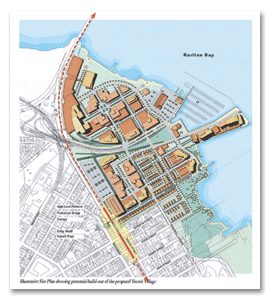New Jersey Transit Villages
Posted by Glenn on August 29, 2006 - 3:27pm in The Oil Drum: Local

One great example of New Urbanist, mixed use development in the Northeast is the New Jersey Transit Village program. Qualifying towns and villages get a high level of cooperation from important state agencies in helping reshape the area and up to $1 million a year in state grants. This would be a great program to emulate along the MTA's commuter rail lines in Westchester, Long Island and Connecticut.
While we continue to discuss congestion pricing as a way to curb the number of people using automobiles to enter the Manhattan Central Business District (south of 60th), there is already a de facto congestion pricing policy in place for New Jersey at all the major Port Authority Crossings - Holland, Lincoln Tunnels and George Washington Bridge. And those crossings are completely maxed out in terms of capacity so, New Jersey state agencies have been working harder and harder on ways to increase the capacity of its heavy and light rail, buses and building transit oriented development. That's where the NJ Transit Villages come in.

South Amboy's Transit Village Design
The criteria to qualify sounds like exactly the types of initiatives that would move that community toward a lower energy and less auto-dependent lifestyle:
A good Transit Village candidate must make a commitment to grow in jobs, housing and population.A designated Transit Village must have a transit facility. This can be a rail or light rail station, ferry terminal, a bus hub or bus transfer station.
The candidate for Transit Village designation must have vacant land and/or underutilized or deteriorated buildings within walking distance of transit where redevelopment can take place.
A Transit Village candidate must have an adopted land-use strategy for achieving compact, transit-supportive, mixed-use development within walking distance of transit. This land use strategy should be based on transit-oriented development (TOD) principles and can be in the form of a redevelopment plan or zoning ordinance.
The candidate must have a strong residential component. This can include mid-rise buildings, townhouses or apartments over first-floor businesses. A wide variety of housing choices within walking distance of transit helps to support transit ridership.
A good candidate will have "ready-to-go" projects. This means at least one transit-oriented project that can be completed within three years.
In order for a municipality to succeed as a Transit Village, it should demonstrate pedestrian and bicycle friendliness. This means clear, direct pathways from the transit station to shops, offices, surrounding neighborhoods and other destinations.
A good candidate views its transit station as the focal point of the community and uses its station plaza as a gathering place for community activities such as festivals, concerts, public ceremonies and farmers markets.
A good candidate includes its transit station in a station area management plan, in a special improvement district (SID) or as part of a Main Street New Jersey designation.
A good candidate should strive to minimize automobile use by maximizing the appeal of transit. One example of this is the concierge service in the Metuchen train station. Commuters drop off errands (such as dry cleaning, packages for mailing, etc.) in the morning and pickup items on the opposite side of the tracks on the way home.
The candidate should provide commuter parking for residents and non-residents. A Transit Village should also strive to reduce parking requirements near transit stations and implement shared parking solutions wherever possible.
The candidate should support local arts and culture. This brings vibrancy and activity to a community. Designating an arts, antique or restaurant district helps make a Transit Village a destination.
The candidate should support the historic and architectural integrity of the community by ensuring that new buildings blend in with the existing buildings. This can be done with architectural design guidelines that govern new building facades, window replacements, awnings, lighting and signs.
The candidate should consider how to incorporate some affordable housing within walking distance of transit since low and moderate income households rely heavily on public transportation.
My only additions to this fine list would be more pedestrian and bike friendly facilities to encourage these forms over automobile use as they increase density.




One of my highest priorities is to eventually move to a transit village or other compact, traditional neighborhood with a train station.
I live in New Jersey, by the way, and look forward to visiting a few of the towns cited on the list of villages you provided. They are our past and our future, and those who won't prepare shall be left behind.
Keep up the good work!
Erwin